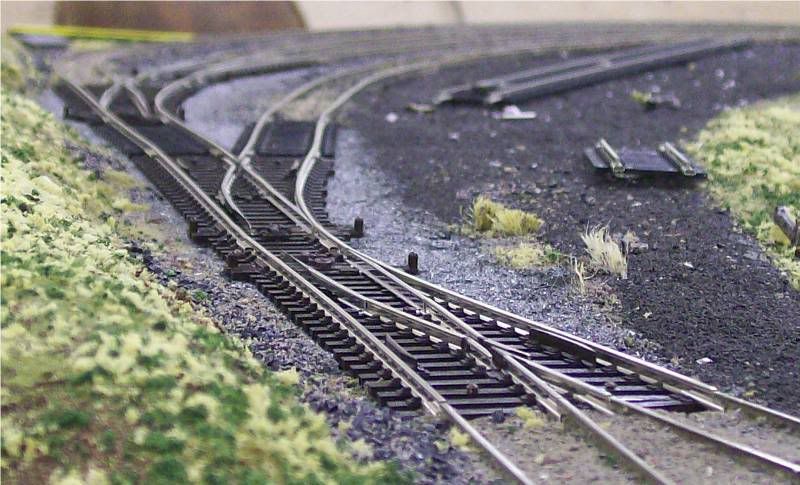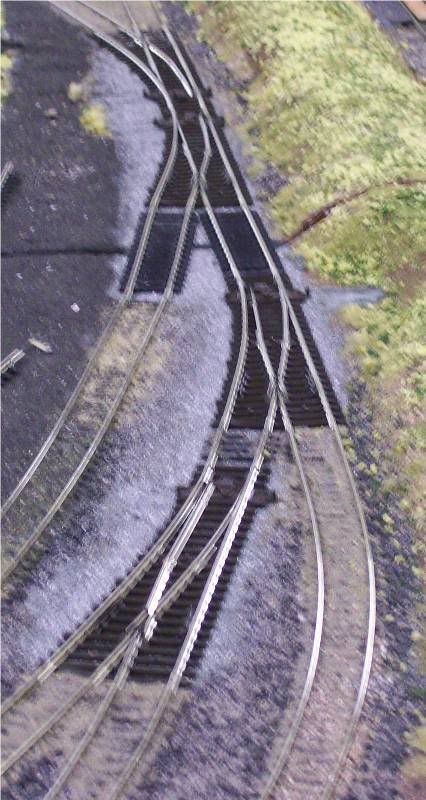Ok, this is a pretty nubey question, but I will be ballasting some time in the future. I was wonder why is it so hard to ballast turnouts? I always hear you guys say how hard it is(I probably will too)but was wondering why? Is it because there are moving parts and tight spaces? So I was wondering, why is it so hard to ballast turnouts? Any advice on how to ballast turnouts?
It isn’t hard to ballast turnouts. It’s hard to use them reliably if you do ballast them carelessly.
I’m not playing with ya…you can ballast turnouts, but don’t glue them very much…at all, since they are the most likely piece of trackwork that you’ll have to yank and replace.
The real problem is when you begin to spill your ballast grains around the moving points rails, and most definitely a huge problem if you pour any over the throwbar and guide timbers. The grit gets under the throwbar and acts like a brake, but it also gets between the stock rails and the point rails, themselves, preventing a flush fit. Reeeeaaaalllly baaaaadddd!
So, what you do is ballast all of the turnout until you get just past the frog towards the points, and then stop and cover the throwbar with 1" wide masking tape. Then, continue, keeping the hinges free, and live with an unballasted 1/2" on either side of the throwbar.
It’s what I do, and it works for me. More meticulous modelers will probably work ballast carefully using a pointed instrument…grain by grain, in and around the throwbar, but not between the two guide timbers…ever!
Moving parts is the main reason. One little bit of glue in the wrong place and you might as well scrap the turnout, unless you get lucky and can clean it out. What I used to do, back when I used flex track, was paint the area under the turnout the same color as the ballast I would be using. I would ballast most of the turnout like the rest of the track but I would leave the areas with moving parts clear and use very little or no adhesive in the turnout area.
In my experience, it isn’t hard at all. You just take your time and make sure that you don’t get glue (or tiny ballast rocks) in the moving parts of the turnout. It takes patience, yes–but it’s worth it in the end.
It is not hard to ballast switches; they do, however, require considerable care. You can get sloppy in a number of areas on a model railroad but if you get sloppy ballasting switches I will gee-go-guarantee you that before you are done correcting the problem you will probably give some consideration to going back to stamps.
If you oil all of the moving parts and joints before ballasting, the glue won’t stick to these areas. Clean off after completed.
I’m going to jump in here with a vote of thanks - [bow][bow]
To Jeffrey - for confirming my suspicions that using ballast-colored cardstock under my turnouts makes as much sense as I thought it would.[:)]
To Bob - for a very helpful hint! Guess I’ll just be a little generous with the Wahl hair-clipper oil when I reach that point (no pun intended)[:-^]
Chuck (still stuck in the netherworld of Central Japan in September, 1964)
And not just directly around the moving parts of the turnout either. Get it done well all up and down the track. Remove anything that isn’t glued down. Any piece of not-glued-down ballast will migrate toward the turnout and eventually find its way under the throw bar and in the points.
I was operating on a well established layout where the turnouts have been installed and ballasted for at least 10 years. As I pulled into town, the engineer of the train leaving said he had derailing problems on the industrial lead. Sure enough, the first cars I tried to back in derailed. Investigating I discovered a single piece of ballast had come loose and wedged in against the rail so the points couldn’t get flush. Annoying stuff that ballast.
I’ve seen the same thing happen in real turnouts. One bit of gravel can cause quite a bit of trouble.
It’s not so much that it’s hard as it is tedious.
Just take your time and be extra careful. You’ll do fine.
Keep ballast out of the points.
It’s not hard at all if you
-
place the balast carefully only between the ties but NOT on top of them
-
soak the turnout and balast well with water and some detergent
-
add the white glue/water from the sides only and let it crawel between all the ties
-
operate the turnout every 5 - 10 minutes for 2 -3 hours after the glue has been added
-
use a switch machine that operates under floor with a wire to move the switches
I’ve ballasted hundreds of turnouts over the years and used all the methods described above. I have mostly used the oil and masking tape. Using a light oil (Wahl’s Clipper Oil) and a paint brush, I would brush on a little bit at the hinges and on the ties under each point rail. I also put a little in between the throw bar and the 2 guide ties and where the throwbar passes under the rails. I also cover this area with a piece of masking tape. After that it’s a bit tedious but easy. Just be sure to use a small brush to clean the balast off the tops of the ties.
Pecos with their switch machines mounted required a little more prep before mounting the turnout. Paint the hole for the switch machine and a bit of the surrounding area black.
If still end up with a frozen turnout, in most cases you can still carefully work it free.
Ballasting turnouts definately isn’t my favorite activity but following the advice given here will definately help to ensure your turnouts continue to work properly. One thing I did in the brief time I modeledin N was to use tape on the turnouts instead of glue. I’d cover the bottom of the N scale turnouts with electrical tape, then put the ballast in place and it would adhere to the tape. This way if I made a mistake, I could remove that piece of tape and start again. I would then put the turnout in place and use the standard glue method to glue ballast to the sides of the roadbed as usual.
I guess my approach is a little different. I try to use ballast sparingly around the moving parts but invariably, bits of ballast will get where it doesn’t belong and the moving parts get glued in place. I make it a point to work them free before the glue completely dries. Then I go around the moving parts and scrape away the excess ballast with a small screwdriver. I find that doing a little maintenance after the fact takes less time then being so meticulous with the application of the ballast. I’ve never ruined a turnout with too much ballast or glue. I work in HO if that matters to anyone.
I agree that oiling the point hinges is a good way to keep the glue out of them, because aside from mechanical interference, you have to be concerned about electrical continuity to the point rails. Harold Minkwitz has tutorials on his site about how to hardwire the points for uninterrupted connections.
I used the speckle paint under the last turnouts I installed.


I haven’t gotten around to putting the rest of the ballast in. I plan on not getting the ballast anywhere near the moving parts. We have had a lot of problems with club members being over-zealous with the ballast and glue, resulting in defective switches.
We used the paint on foam. Laid on a thick coat of acrylic paint, then spray with the speckle. No melting of foam, as the acrylic made a barrier layer. We are also using it under the bridge plates between modules. We were using 3" pieces of Tru-Scale track and roadbed, but they are 1/4 " thick. The cork roadbed is 3 mm; the heights don’t match, so much sanding, fitting, ensued. Now going to 3" pieces of Snap-Track, running the cork all the way to the end of the modules, with the speckle paint giving the appearance of ballast.
Take the easy(?) way out. Glue ties down. Ballast next, but keep between throwbar header ties clear. Sand tops of ties which clears any high ballast at same time. Vacuum the dust up, and spike your rail down at your leisure.
The short version: handlay your track, and you can ballast before the rail goes on. [}:)]
Fred W